Last updated on 10/14/2015
10/13/2015: That’s the latest from the faculty club – no more money down this hole. It’s nice how even the rumors are more optimistic at UO these days.
But don’t forget how much effort it took to end this, if it’s really ended: public records requests, a petition to the DA after UO’s General Counsel told the PRO office to stonewall, then a full blown five story investigative report from RG reporter Diane Dietz, and a lot of UO donors asking “What the F” is our university wasting money on now?
9/16/2015: New VP Kyle Henley drops in on 160over90, asks how Clevenger blew $5M
That’s the rumor from the SOJC profs watching Mad Men reruns down at the faculty club tonight. Meanwhile VP for branding Tim Clevenger has been moved out of JH, to a suite far, far away from campus. We’re still paying him $209.625 a year though. Fire Clevenger and UO could hire, say, 2 new Human Physiology profs, with money left over for startup. Or give 15 full-ride scholarships to Oregon National Merit Scholars, including dorms and meals.
So which is it gonna be, Mr. Henley?
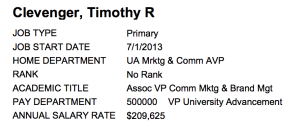 |
 |
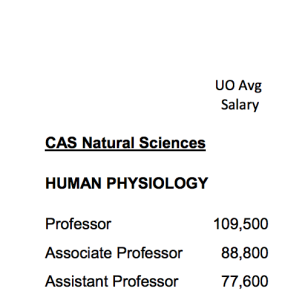 |
Here’s hoping our new general counsel Kevin Reed can also find a way out of the 160over90 contract, which UO’s misnamed Public Records Office is still hiding from the public.
Meanwhile Mike Schill is off to the Pendleton Roundup, to see how branding is really done. Keep the iron hot and make your mark, Mr. President:
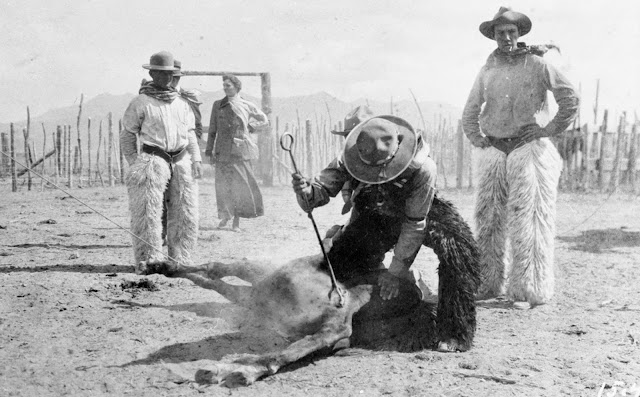
8/26/2015: Tim Clevenger to get the boot for 160over90 branding mess?
The rumor from a generally well-informed source down at the faculty club is that I’m not the first person who’s heard of Google Trends, and that Clevenger’s branding campaign is failing on other metrics as well. Meanwhile hits to the Crap-Free UO Homepage (TM) are way up.
8/19/2015: Tim Clevenger’s $5M 160over90 branding campaign fails Google buzz test
A few years ago the UO Economics department invited Google’s Chief Economist Hal Varian out to give a talk to our undergrads. Among the topics was Google Trends, which lets you compare how often people search for different search phrases across time. Very interesting, the slides are here.
Try it here. Here’s what you get if you compare the frequency of searches for “university of oregon application” with searches for a few of our competitors in the market for undergrad students. Blue for Colorado, red for Arizona, yellow for Oregon State, Green for UO, and purple for last year’s BCS champions Ohio State:
If there’s any impact from the rollout of UO’s $5M “What the If?” branding campaign, which started in March 2015, it would take a pretty creative econometrician to make the t-stat significant.
Oh well, there goes that $5M. Here’s hoping our donors will cut off UO’s $207K-a-year AVP for branding Tim Clevenger and $5M 160over90, and redirect those generous gifts towards, say, teaching and research.
Also no apparent effect from football. The Ducks win, the Beavers lose, it really doesn’t matter.
For more on UO’s branding and how hard UO tried to hide the public records showing how much we spent on it, check out Diane Dietz’s stories in the RG, links here.
And in response to comments here’s the last year of weekly data – noisier, and some spikes that may well be from football, but I still don’t see the branding buzz:
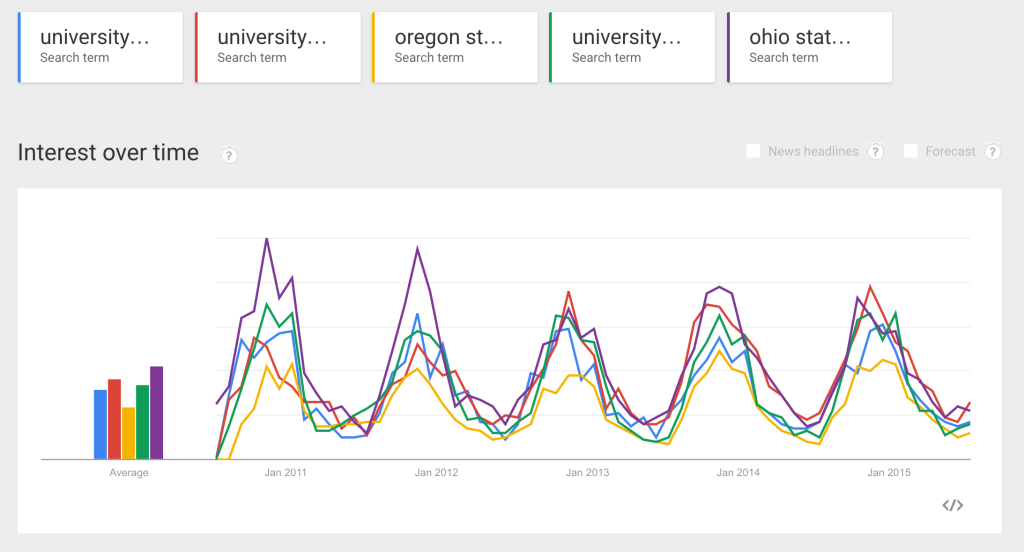
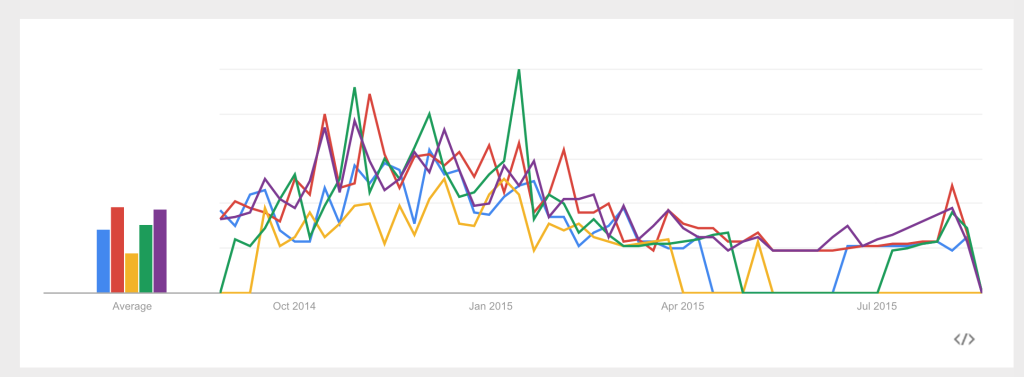
Nice colors and patterns. I can almost see the pieta in there. The most important factors about a university work at long- run, low frequencies not evident on the graph, but nice graph anyway!
While it could be too early to speculate, perhaps we will get lucky and the new Prez will elect for a “crap-free” Johnson Hall???
As I read the graph, only the last 4 (or so) data points are relevant. Was a positive signal expected that quickly? Please bring us a report in a year or two.
I doubt that the campaign will work, but 4 (or so) months doesn’t give them much time to show what they can do.
That’s what’s great about these data – if there’s an impact it should show up quickly. See Varian’s presentation. But even if it does, there’s a lot of shrinkage between a HS student or their parents googling “university of oregon admissions” and the student completing an application, getting admitted, accepting, and actually showing up on campus. If Clevenger can’t even move the needle on the real-time google search data, he’s just pissing away money.
This is so telling. Will anyone in JH listen? (Schill… you are still listening, right?)
I hope their campaign has counteracted the recent Shangha ranking of world universities, in which OSU again came out ahead of UO. The Oregonian made hay of this the last couple of days. When is UO going to start attracting undergrads with better SAT’s? We should aspire to catch up with schools like Kansas and Oklahoma. That might be the quickest thing we could do to try to stay in the AAU.
Yup. $5M a year for scholarships for top students would do a world of good for UO. Offer them to all Oregon merit finalists.
Too bad Clevenger got that money instead of the students. That decision was made before Schill, maybe he’ll convince Connie Ballmer she was led astray.
I believe that Oklahoma gives a great scholarship to all National Merit finalists, or something like that — and publicizes it — with great results.
The publicity from this would be the best thing UO could do immediately — it would proclaim “academics, academic, academics” as someone once said — just do it! (as someone else once said);
Not here to defend anyone — and I agree — luring top students with $ is always a good idea, but…I don’t think you can think about branding and marketing through economist’s brain, look for hard core or even measurable results in a few months, and declare whether a campaign worked or is working. “Buzz” isn’t the only thing the campaign is looking for — nor is it focused on short-term results. This is a many pronged approach that is looking to increase “brand recognition” and improve it in the marketplace. It’s almost an art — and so far, I think it’s been going pretty well. In addition to the adds, the university is working on getting UO experts in front of the media and quantifying quotes and the mention of studies. The entire program is focused on academics — not athletics — and it will take time and our continued hard work at scholarship, media exposure, and the campaign to see if it works.
So far, I’ve been pretty impressed with direction we’re moving in on the marketing front and on the administration front. I hope we keep going until our place in the AAU improves. (Although I’m not sure why I care about a group of universities that is essentially lobbying group).
Wow, an argument from faith. It’s been a while since I heard one of those from a professor. Or is it an argument from self-interest? What discipline do you work in?
I agree. But in all fairness, we have pretty much no idea how to measure anything about how a university is performing, except for extremely concrete indicators like faculty grants. And even those are subject to multiple interpretations.
well, measuring the SAT’s of the incoming freshmen (first years?) shouldn’t be so hard. In fact, it isn’t, and the data show stagnation of UO for decades, also that we lag behind places like Kansas in that respect. (One of our lowest ranked AAU competitiors) You would think that people at UO woulda done woke up about that, oh, maybe 20 years ago when AAU was becoming a concern?
Certainly not science, lord of all disciplines.
Phrased differently, I took UOFaculty’s point to be that exposure over time is where the proof will really lie. Prof. Harbaugh’s use of Google is not without its flaws. For example, when I applied to college (in 2006) I didn’t Google any applications. Most college websites, if they get anything right, effectively drive traffic from homepage to application. Anyone who didn’t use that specific search term wouldn’t show up in this graph.
Also, new students aren’t even getting the rebranded materials yet. This incoming class received the pre-160over90 stuff.
I’m skeptical of some of the marketing, too, but I think it’s reasonable to ask for a little more rigor out of a critique.
“Adds”. Faculty. Really?
It’s remarkably difficult to find recent, broad-scale,, unbiased studies correlating university marketing expenditures to changes in enrollment in higher education, or to student quality, or to fundraising success (three easy-to-track outcomes). I hope readers might post anything relevant. I found this from the UK, which supports my suspicion that the marketing emperors have no clothes: https://www.timeshighereducation.co.uk/news/marketing-spend-up-but-applications-fail-to-follow-suit/2012107.article
Thanks – the Times reporter gets an appropriately skeptical quote:
Commenting on THE’s figures, Roger Brown, emeritus professor of higher education policy at Liverpool Hope University, said that universities had “got their priorities wrong”.
“The truth is that almost all of this is a waste of money, as there isn’t really any evidence that students are influenced in making their choices by university marketing strategies,” he said.
Professor Brown called on funding bodies to monitor student marketing spending “because this is money that could be used to improve teaching”.
I followed the link in the story to this paper, by Dr Chris Chapleo of Bournemouth University with Communications Management http://www.communicationsmanagement.co.uk/site/assets/files/1365/the_effect_of_increased_tuition_fees_on_he_marketing.pdf
Given that it’s written by a marketing professor who apparently does higher ed consulting on the side, it’s not a surprise to find the paper concludes that marketing is important for UK colleges:
12. Overall, for the majority of UK higher education institutions (HEIs), investment in marketing (particularly non-staff budgets) is important and continuing.
While the data he presents shows that UK higher ed marketing costs a lot of money, it does nothing to show that marketing expenditures have any effect on enrollment. Doesn’t even try.
I don’t know about marketing expenditures. But there are examples of universities of various levels of repute that have managed to vastly improve their standing. I posted a link recently about Northeastern University. Another good example is the University of Chicago, which very consciously went about raising the profile of its undergraduates, and succeeded spectacularly. There must be others out there. UO would do well to pay attention.
Yes – maybe a UO Senate committee should look into sensible alternatives to Clevenger’s “What the If” marketing.
I’m not defending the marketing voodoo, but it might be the case that since everyone else comparable to UO is also engaging in “branding,” not following suit might have a negative impact on image and enrollment. So UO might need to spend millions on marketing, along with climbing walls and apartment-style dorms, just to stay where we are.
Diff,
That may be the case but I think if a no cost offer comes from a good school the students will go to that school regardless of the three and a tree portfolio.
Of course the best students, the really top high school students are amazing and very impressive. They are thoughtful, articulate, and logical with mad skills and interests in diverse complex subjects. Branding, may indeed work on some students but not these students. Are the students who are here because of the glossy ad campaign really the students we want? I suppose if all we care about is that their tuition check (or more correctly loan) is fungible then that is exactly the students we want, free cash, too stupid to graduate and too dumb to quit.
The key thing for me is pretty easy to do. Randomize the market impact regions out of state a bit, and see exactly what the yield rate. Don’t assume every dollar spent will pay for itself. Then compare that against generous financial offers to strong out of state students.
awsome0, yes, I suspect that your average high schooler running an e-commerce drop ship store for beef jerky knows more about A/B testing and other ways to ensure a maximum return on marketing dollars compared to the current UO campaign.
I’m guessing our strategic branders know how. Or at least they know a well paid consultant who does. But they also know what they will find.
“What the if” is an embarrassingly stupid slogan and his head should roll just for that. BTW, if you google it you don’t get any reference to UO, nor any information about how great we are, but the seventh hit brings you back to Bill’s Crap Free homepage! Well done.
Do we really need a pun based on the phrase “What the fuck?” as our university slogan? I thought we left this kind of sophomoric humor behind in middle school. Instead we’re paying through the nose for this crap.
I’m waiving the normal one cuss word limit, for all comments related to 160over90 and their inane campaign.
Hello? The failed branding experiment was “What if?”, not “What the if”. See http://exploreif.uoregon.edu The latter slogan was UoM’s tongue-in-cheek take on it. Obviously UoM was convincing enough that people fell for the joke.
Thanks, but this branding shit is so dumb that the joke wrote itself. And the fact the joke is more popular than the real slogan is all our new VP for Communication needs to know.
On the plus side, it’s been taking the psychic bad taste of “Powered By Orange” out of my memory…
If you google “What If?” you get–well you get a whole lot of things, including the trailer for a Daniel Radcliffe movie of that title. I quote part of the Rotten Tomatoes review: “Critics Consensus: Its narrative framework may be familiar, but What If transcends its derivative elements with sharp dialogue and the effervescent chemistry.”
Just add “department” at the end and you’ve saved a few million $$$$
I keep waiting for the mugs and t-shirts to show up in the UO Matters store. Please. Maybe we need a design contest for “What the if” merch that stays just a hair’s breadth on this side of a lawsuit.
Correction: the slogan is “We if” not “What if.”
I stand corrected. Damn. It’s not even memorable.
Off to if.
I think it might just be “If”. As in
If you can bear to hear the truth you’ve spoken
Twisted by knaves to make a trap for fools, …
http://www.poetryfoundation.org/poem/175772
Watch the TV commercial again. It’s “We if.” Some people pronounce it “whiff.”